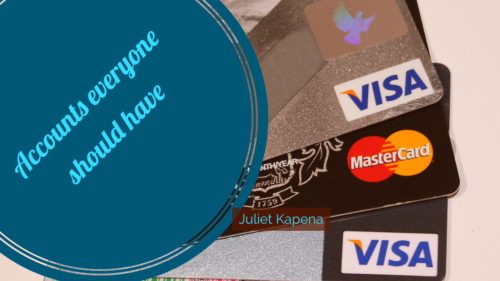
Your checking account is not your savings account. An important step to take when beginning your journey to financial freedom is ensuring that you have distinctive accounts to help you meet your financial goals.
Whilst majority of the banks offer a variety of options, bank accounts can be broadly divided into five types:
Savings accounts
Basic checking accounts
Interest-bearing accounts
Money market deposit accounts
Certificates of deposit
At the very least, you should have three accounts that perform three distinctive functions . One to carry out basic transactions (short-term), one to save on a short to medium-term basis (this account could also be used to build up your emergency funds) and an interest bearing account(long-term).
What you have left in your checking account after paying your bills cannot be and should not be categorized as your savings. In fact, paying your future self (saving), should be categorized as a bill payment you owe every month or each time you get paid.
Most banks offer these types of accounts, so the bank you choose probably won’t restrict this decision. It does make sense to know the account type you want first so you can focus on that type as you shop around to various banks. Here is a brief description of each type of account:
Savings accounts
These are intended to provide an incentive for you to save money. You can make deposits and withdrawals, but usually can’t write checks. They usually pay an interest rate that’s higher than a checking account, but lower than a money market account or certificate of deposit account. Some savings accounts have a passbook, in which transactions are logged in a small booklet that you keep, while others have a monthly or quarterly statement detailing the transactions.
Checking/Current Accounts
Interest-Bearing Accounts
These offer a more comprehensive set of services, but usually at a higher cost. The interest rate often depends on how large the balance in the account is and most charge a monthly service fee if your balance falls below a preset level.
Money Market Deposit Accounts
These accounts invest your balance in short-term debt such as commercial paper, treasury bills, or CDs. The rates they offer tend to be slightly higher than those on interest-bearing accounts but they usually require a higher minimum balance to start earning interest.
Certificates of Deposit
With these sort of accounts, the account holder agrees to keep the money in the account for a specified amount of time, anywhere from three months to six years. Because the money will be inaccessible, the account holder is rewarded with a higher interest rate, with the rate increasing as the duration increases. Early withdrawal might attract a penalty, so don’t select this option if you think you might need the money before the time period is over (the “maturity date”).